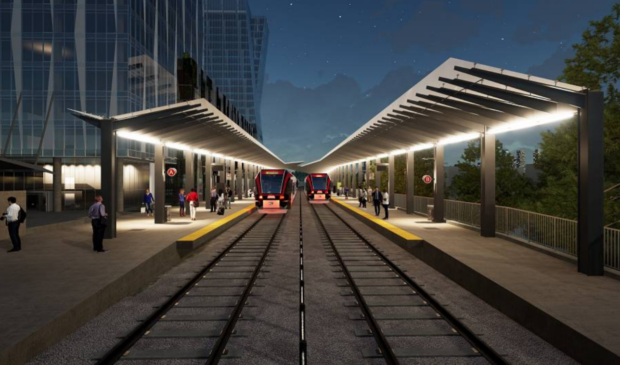Broadmoor rail station to break ground in September, replace Kramer station
Thursday, August 27, 2020 by
Ryan Thornton A new Red Line commuter rail station will break ground next month, directly servicing the Domain and the future $2 billion mixed-use Broadmoor development by summer 2022.
The Capital Metropolitan Transportation Authority board approved a public-private partnership with Brandywine for the $24 million double-platform station on Monday, committing to pay no more than $12 million, half of the estimated project costs.
“This is something that we’re really excited about – having a gateway on the Red Line and making transportation to and from the burgeoning second downtown at the Domain and Broadmoor a reality,” Williamson County board representative Eric Stratton said.
In 2018, Capital Metro sought a $7.7 million federal grant to pay part of the estimated $16.7 million cost of moving the Kramer station half a mile north to the Broadmoor site at 11501 Burnet Road. Among reasons cited were the lack of transit-supportive land uses surrounding Kramer station as well as a lack of parking spaces for transit customers. Despite the need, Capital Metro did not receive the grant from the U.S. Department of Transportation.
The project has since grown in scope to include two side-loading platforms, over half a mile of new double tracking to ease rail operations and more than 400 shared parking spaces for transit customers. Sharmila Mukherjee, executive vice president of planning and development, told the board the station may also be an ideal location to pilot innovations for the evolving MetroBike program.
Capital Metro expects the new station, which is located directly adjacent to the Broadmoor development – also known as Uptown ATX – to see 240,000 annual boardings to Kramer station’s 90,000. Mukherjee told the board in May that with Project Connect boardings at Broadmoor could be four times more than at Kramer, second only to Downtown Station.
In addition to moving Kramer station half a mile north, Capital Metro is preparing to build a new rail station a mile south of Broadmoor at McKalla Place, future home of the Austin FC, resulting in two rail stops between Crestview and Howard stations. At this month’s meeting of the agency’s Customer Satisfaction Advisory Committee, Jacob Calhoun, a transportation planner, confirmed that Kramer station will be retired from use once the McKalla Place station is up and running.
Capital Metro CEO Randy Clarke said the improvement is part of a larger set of ongoing efforts aiming toward a “better Red Line, which ultimately in theory connects to, depending on what happens in November, a larger connected system as well.” The agency has identified $25 million in the Project Connect $7.1 initial investment on the November ballot for improvements to the Red Line, including signaling and other infrastructure for the McKalla station.
While the final design has not been made public, Brandywine spokesperson Laura Miller confirmed for the Austin Monitor on Wednesday that the Broadmoor development will be a destination for approximately 16,000 employees and provide roughly 3 million square feet of residential space. Miller could not verify a specific number of residential units or percentage that would be income-restricted, but an announcement may provide more details in mid-September.
Compared to the high-capacity light rail Orange and Blue lines of Project Connect, the Red Line serves a relatively high-income customer base. Median income along the Red Line corridor is around $67,000 compared to $49,000 along the Blue Line and $54,000 along the Orange Line. The Red Line also services fewer affordable housing units than either the Orange or Blue lines.
In April 2018, Council Member Leslie Pool said there were ongoing discussions with Brandywine to require 50 percent of any affordable housing units that are built in exchange for additional building height be located at the project site.
Besides residential, the Broadmoor will ultimately offer over 3 million square feet of office space on the 66-acre property. Citing a transit study from a Denver transit organization, the board’s CAMPO representative Terry Mitchell said 61 percent of office users located within a quarter-mile of a transit stop would likely use the transit option, making office space the best use for transit ridership.
“It was a little bit less for residential, but if we in our respective governments will consider where there’s opportunities to add office and add housing at our stations along the Red Line, we will greatly increase that ridership,” Mitchell added. “So, just as a thought, it’s good planning.”
In February, before Covid-19, Capital Metro’s Red Line carried over 67,000 passengers. In June, the rail line served under 14,000 passengers.
Broadmoor station rendering courtesy of Capital Metro.
The Austin Monitor’s work is made possible by donations from the community. Though our reporting covers donors from time to time, we are careful to keep business and editorial efforts separate while maintaining transparency. A complete list of donors is available here, and our code of ethics is explained here.
You're a community leader
And we’re honored you look to us for serious, in-depth news. You know a strong community needs local and dedicated watchdog reporting. We’re here for you and that won’t change. Now will you take the powerful next step and support our nonprofit news organization?









